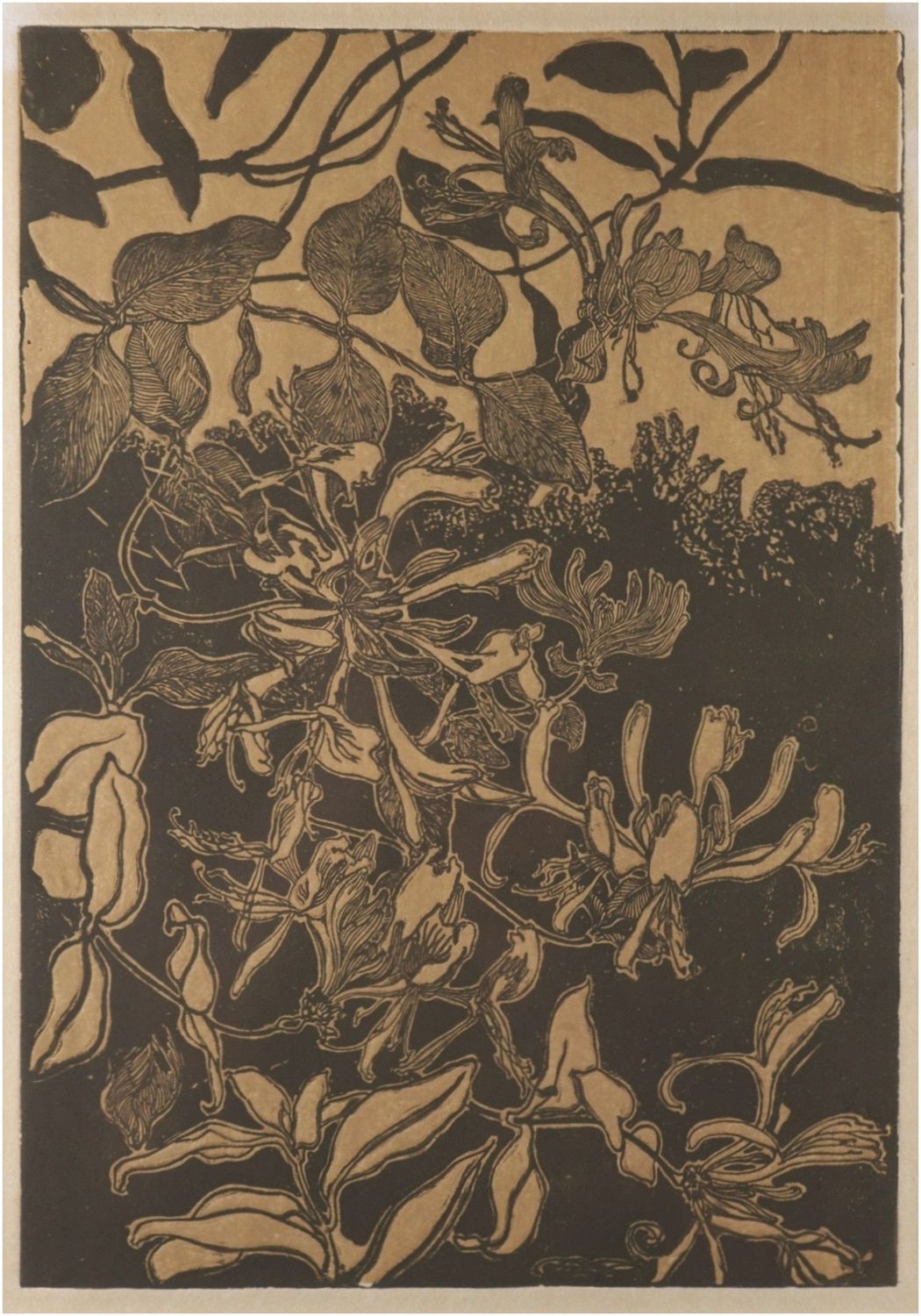Illies, Arthur (1870-1952), Blühender Busch, 1896
Arthur Illies(1870 Hamburg – 1952 Lüneburg), Blühender Busch, 1896 (GWV-Nr. 31 a). Radierung und Zinkhochätzung in Chiaroscuro-Manier, 35,7 x 25,1 cm (Darstellung), 59 x 47 cm (Rahmen), unsigniert, im Passepartout hinter Glas gerahmt.
- minimal gebräunt, sonst in sehr gutem Zustand und ansprechend gerahmt
Exposé als
PDF
- Dynamische Inversionen -
Arthur Illies hatte der Kunstakademie 1892 den Rücken gekehrt, nachdem er erkannt hatte, dass die Natur selbst die eigentliche Akademie des Künstlers darstellt und der in der Freilichtmalerei zu erschließenden Landschaft das Studium zu gelten habe. Innerhalb dieser Phase von Illies künstlerischem Werdegang brachte ihm Justus Brinkmann, der Direkter des Hamburger Museums für Kunst und Gewerbe, die ostasiatische Grafik nahe. Umgehend inspiriert, eignete sich Illies das künstlerische Ausdrucksmittel der Druckgrafik an. Mit ihr konnte er die durch eine Flächigkeit bestimmte Ästhetik der fernöstlichen Grafik mit seinen Naturstudien verbinden. Illies war derart davon angetan, auf diese Weise zu einer Synthese zu gelangen, dass er mit den Drucktechniken selbst zu experimentieren begann.
„Illies hat nicht nur in den bekannten graphischen Verfahren […] zahlreiche Blätter geschaffen, sondern auch eigene Techniken erfunden.“
- H. Schröder
Ein Resultat dieser Experimente steht hier vor Augen: Die Zinkhochdruckätzung erzeugt einen Prägedruck, bei dem die Oberfläche des Blattes eine Reliefstruktur bekommt und haptisch erfahrbar wird. Dieser Effekt geht mit einer Hell-Dunkel-Inversion einher. Die Grafik hat unten eine dunkle und oben eine helle Hintergrundzone. Vor der dunklen Zone erscheinen die Blätter hell, vor der hellen Zone hingegen dunkel. Diese Hell-Dunkel-Inversionen verbunden mit der Reliefwirkung verleihen dem Blatt eine Dynamik, die motivisch in den Pflanzen selbst zur Darstellung kommt. Die Blätter und Blüten wachsen von mehreren Seiten ins Bild hinein und steigern sich zur Bildmitte hin zu einem Crescendo. Vor dem flächigen Hintergrund scheinen sich die Blüten in den Realraum hinein zu entfalten. Die einzelnen Blüten stehen dabei aber nicht für sich, vielmehr sind sie kaum voneinander zu unterscheiden, wodurch eine Fokussierung auf das Gesamtgeschehen erfolgt, was die Dynamik abermals intensiviert.
Arthur Illies schafft hier ein Naturschauspiel, das bis in die kleinsten Details hinein von einer vitalen Spannung getragen wird. Eine lebendige Ornamentik, die sich stets weitertransformiert, ohne zu einer endgültigen Form zu gerinnen.
zum Künstler
Nach einer Ausbildung zum Dekorationsmaler in Hamburg nahm Arthur Illies 1890 das Studium an der Münchner Kunstakademie bei Johann Caspar Heterich auf. Keine zwei Jahre später hatte er jedoch ein Schlüsselerlebnis, das ihn dazu führt, die Akademie zu verlassen:
„Ostern 1892 stand ich während eines Aufenthaltes in Hamburg vor einem niedersächsischen Bauernhof in Langenhorn, und da fiel es mir wie Schuppen von den Augen, dass ich hier etwas sah, das mir innerlich näher stand als alles, was die Akademie und München mir allenfalls geben konnten.“
- Arthur Illies
Von Alfred Lichtwark, dem Direktor der Hamburger Kunsthalle, unterstützt, kehrt Illies nach Hamburg zurück und widmetet sich in den Folgejahre zusammen mit Ernst Eitner, Paul Schroeter und Thomas Herbst der Freilichtmalerei zunächst im Hamburger Umland und mit Paul Kayser und Alfred Mohrbutter später auch in der Heidelandschaft. Neben Alfred Lichtwark war Justus Brinkmann, der Direkter des Hamburger Museums für Kunst und Gewerbe, ein Mentor für Illies, der ihm die ostasiatische Druckgrafik nahebrachte.
1897 war Illies Gründungsmitglied des Hamburgischen Künsterclubs , in dem sich die einer neuen Kunst zugewandten „Jungen Hamburger“ zusammenfanden. Dazu gehörten neben Arthur Illies: Julius von Ehren, Thomas Herbst, Ernst Eitner, Paul Kayser, Alfred Mohrbutter, Friedrich Schaper, sowie Arthur Siebelist.
Ab 1899 ließ Illies in der Huuskoppel sein nach eigenen Entwürfen gestaltetes Wohnhaus errichten.
1907 folgte der Künstler zusammen mit Ernst Eitner der Einladung Georg Burmesters nach Heikendorf an der Kieler Förde, wo er sich dem Sujet des Meeres annahm.
Ebenfalls 1907 bezeugt der Großauftrag, die 1970 abgerissenen Villa des Unternehmers und Kunstsammlers Henry B. Simms in Hamburg mit 14 Wandgemälden auszustatten, von seiner künstlerischen Reputation. 1914 wurde Illies ein Atelier in der Kunstgewerbeschule zugesprochen und er beteiligte sich in demselben Jahre an der wegweisenden Kölner Werkbundausstellung.
Im Auftrag des Museums für Hamburgische Geschichte reiste Illies 1916 an die Ostfront. Nach den einschneidenden Kriegserlebnissen widmete er sich der religiösen Malerei. 1928 malte er die 1943 zerstörte alte Erlöserkirche in Hamburg-Borgfelde aus und 1930 schuf er ein Altargemälde für die Phillipuskirche in Hamburg-Eimsbüttel.
Was Illies' Lehrtätigkeit angeht, so war er von 1895 bis 1908 Lehrer an der Malschule für Damen von Valesca Röver und ab 1908 Dozent an der Staatlichen Kunstgewerbeschule in Hamburg. 1926 wurde er schließlich dort zum Professor berufen.
Illies war Mitglied im Kampfbund für deutsche Kultur und trat 1933 der NSDAP bei, wurde jedoch im selben Jahr als Professor entlassen. Dennoch beteiligte er sich von 1941 bis 1944 an den Großen Deutschen Kunstausstellungen und verkaufte 1943 ein Gemälde an Joseph Goebbels.
Seit 1937 in Lüneburg ansässig, verlor Illies 1945 seine Wohnung und zog in das Atelier im Alten Kaufhaus ein. Ebenfalls 1945 begann er unter Sehstörungen zu leiden. Im letzten Abschnitt seines Lebens widmete er sich fast ausschließlich der Stilllebenmalerei. 1952 verstarb Arthur Illies in seiner Atelierwohnung.
Auswahlbibliographie
Gustav Schiefler: Arthur Illies. In: Verzeichnis des graphischen Werks neuerer hamburgischer Künstler bis 1904. Hrsg. v. Alfred Lichtwark, Hamburg 1905, S. 65–110.
Gustav Schiefler: Das graphische Werk von Arthur Illies. 1894 – 1904. Hrsg. v. Gerhard Schack, Hamburg 1970.
Kurt Illies (Hrsg.): Arthur Illies. 1870–1952. Aus Tagebuch und Werk, Hamburg 1981.
Kurt Illies (Hrsg.): Arthur Illies. Graphik und Zeit. 1894–1952, Hamburg 1983.
Kurt Illies (Hrsg.): Arthur Illies. Zeichnungen - Briefe - Lüneburg, Hamburg 1985.

